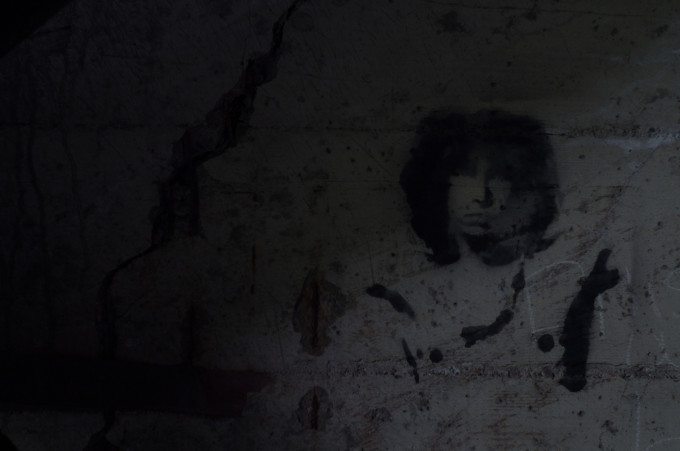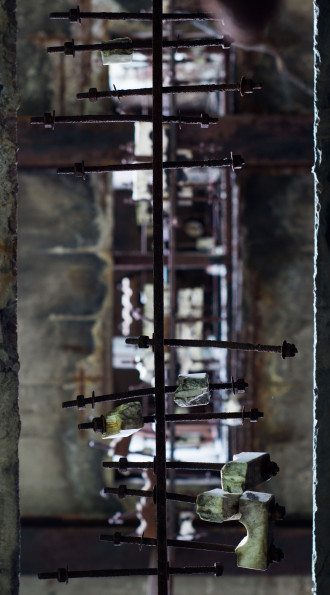Last Updated on 11/21/2014 by Julius Motal
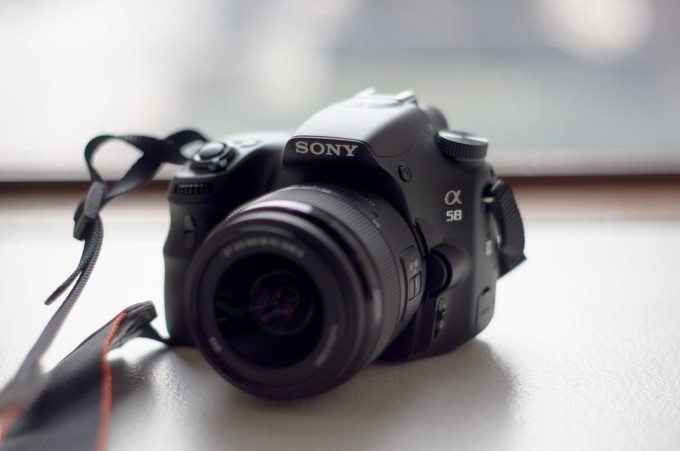
I got my first taste of this camera back at a Sony event held at the Museum of Natural History in New York City. The event wasn’t strictly about photography, but they were showcasing some of their newest cameras. I sketched my first impression of the camera after my few hours with it, and a few months later, I had it in my possession for a month. With 20.1MP, an APS HD CMOS censor, and smooth contours, the a58 can take some fantastic photos. I took it out alongside my a580, the a58’s portly older brother. As time progressed, I found that I warmed up to this camera, more so than I did initially.
Pros and Cons
Pros
-Excellent image quality
-Smooth form factor
-Great companion camera
Cons
-EVF is difficult to deal with in low light
-The AEL and AV buttons have switched with the SLT-line (a minor con, but it caused some confusion)
Gear Used
I used the Sony a58 with the Minolta 50mm AF f/1.7 and the Samyang 85mm f/1.4.
Tech Specs
Specs taken from the Adorama listing.
| Lens Compatibility | Sony A-mount, operation with Minolta/Konica Minolta Maxxum lenses |
| Lens Mount | Sony A-mount |
| Camera Type | Interchangeable Lens Digital SLT camera |
| Imaging Sensor | Exmor APS HD CMOS sensor (23.5 X 15.6mm) |
| Processor | BIONZ image processor |
| Anti Dust | Charge protection coating on Low-Pass Filter and electromagnetic vibration mechanism |
| Pixel Gross | Approx. 20.4M pixels |
| Effective Picture Resolution | Approx. 20.1M pixels |
| Focal Length Conversion Factor | 1.5x |
| Color Filter System | RGB primary color filters |
| Media Type | Memory Stick PRO Duo /Pro-HG Duo media; SD, SDHC and SDXC memory card |
| Color Space | sRGB standard (with sYCC gamut) and Adobe RGB standard compatible with TRILUMINOS Color |
| Still Image Mode | JPEG (Standard, Fine), RAW, RAW+JPEG |
| Still Image Max Effective Resolution | L (20 MP) 5456 x 3632 |
| Still Image Size 16:9 | L (17 MP) 5456 x 3064, M (8.4 MP) 3872 x 2176, S (4.2 MP) 2736 x 1536 |
| Still Image Size 3:2 | L (20 MP) 5456 x 3632, M (10 MP) 3872 x 2576, S (5 MP) 2736 x 1824 |
| Panorama Still Image Size | Horizontal Wide: 12,416 x 1,856 (23M) Horizontal Std.: 8,192 x 1,856 (15M) Vertical Wide: 2,160 x 5,536 (12M) Vertical Std.: 2,160 x 3,872 (8.4M) |
| Video Format | AVCHD / MP4 (MPEG-4 AVC (H.264)) |
| Video Mode AVCHD | FX – 1920 x 1080/60i at 24Mbps FH – 1920 x 1080/60i at 17Mbps FX – 1920 x 1080/24p at 24Mbps FH – 1920 x 1080/24p at 17Mbps |
| Video Mode MP4 | HD – 1440 x 1080/ 30p at 12Mbps VGA – 640 x 480/ 30p at 3Mbps |
| Video Signal | NTSC color, EIA standards |
| Audio Format | Dolby Digital (AC-3) / MPEG-4 AAC-LC, 2ch |
| Microphone/Speaker | Built-in Stereo Microphone |
| Still Image File Format | JPEG (DCF Ver. 2.0, Exif Ver.2.3, MPF Baseline compliant), RAW (Sony ARW 2.3 format), RAW & JPEG |
| Type | 1/2″ SVGA EVF (Electronic viewfinder) (1,440k dots)” |
| Diopter Adjustment | -4.0m to +4.0m-1 |
| Field of View | 100% |
| LCD Type | 2.7″ TFT Clear Photo LCD (460,800 pixels) |
| Angle Adjustment | Tilt angle: Up approx. 135 degrees, downward approx. 55 degrees |
| Brightness Control | Auto, Manual (5 steps between -2 to +2) |
| Coverage | 100% |
| Live View | Continuous Live View (LCD/EVF Auto, selectable) |
| Real-time Image Adjustment Display | Yes(On/Off) |
| Histogram | Yes(On/Off) |
| Peaking | Yes (Level setting: High/Mid/Low/Off, Color: White/Red/Yellow) |
| Grid Display | Yes (Rule of thirds, Diagonal, 4×6 Square Grids, Off) |
| Customization | Grid, Histogram display, Grid Line, Magnified display for playback |
| Focus System | TTL phase detection AF (CCD line sensors) |
| Focus Points | 15 points (3 points cross type) |
| AF Modes | Single-shot AF(AF-S), Continuous AF(AF-C), Automatic AF(AF-A) selectable, Direct Manual Focus (DMF), Manual Focus |
| Focus Area | Wide (Auto,15 points)/ Zone/Spot/Local selectable |
| Focus Sensitivity | EV -1 to 18 EV (at ISO100 equivalent, with F2.8 lens attached) |
| Focus Features | Predictive control (AF-A, AF-C), Focus Lock, Eye-start AF |
| AF Illuminator | Built-in LED, Range: approx. 3′ – 21′ (1m-7m) |
| Metering | Advanced 1200-zone evaluative metering |
| Metering Modes | Multi-segment, Center-weighted, Spot |
| Metering Sensitivity | -2EV to 17EV (at ISO 100 equivalent w/ f/1.4 lens) |
| Exposure Compensation | Still images: +/-3.0 EV(1/3EV steps selectable) Movies: +/-2.0 EV(1/3EV steps selectable) |
| Exposure Settings | iAUTO, Flash Off, Superior Auto, Scene Selection, Sweep Panorama, Continuous Advance Priority AE, Movie, Picture Effect, Programmed AE (P), Aperture priority (A), Shutter-speed priority (S), Manual (M) |
| Scene Mode(s) | Portrait, Landscape, Macro, Sports Action, Sunset, Night Portrait, Night View, Handheld Twilight |
| Picture Effect(s) | 11 types (15 variations): Posterization (Color, B/W), Pop Color, Retro Photo, Partial Color (R,G,B,Y), High Contrast Monochrome, Toy Camera, Soft High-key, Soft Focus, HDR Painting, Rich-tone Monochrome, Miniature |
| D-Range Optimizer | Yes: (Auto, Level, Off) |
| Auto Exposure Lock | Yes (AE Lock button) |
| Color Temperature | 2500 – 9900K with 15-step each Magenta/Green compensation (G7 to M7), AWB micro adjustment |
| Creative Style | Standard, Vivid, Portrait, Landscape, Sunset, Black & White (Contrast (-3 to +3steps), Saturation(-3 to +3steps), Sharpness(-3 to +3steps)) |
| Exposure Bracketing | Cont./Single, w/ 1/3 EV,1/2 EV,2/3 EV,2.0EV,3.0 EV incmnts,3/5 frames (2.0EV,3.0EV:only 3 frs) sel |
| ISO | Stills: ISO 100-16000 selectable in 1 EV steps, Auto (100-3200) Movies: ISO 100-3200 selectable in 1 EV steps, Auto (200-3200) |
| Noise Reduction | Long Exposure NR: (On/Off, available at shutter speeds longer than 1 second) High ISO NR: (High/Normal/Low) |
| White Balance Mode | Auto, Daylight, Shade, Cloudy, Incandescent, Fluorescent (Warm white, Cool white, Day white, Daylight) , Flash, Setting the color temperature, Color Filter, Custom |
| Burst Buffer | Tele-zoom Continuous Advance Priority AE: Fine: 16 frames, Standard: 19 frames Continuous shooting: Fine: 7 frames, Standard: 8 frames, RAW & JPEG: 5 frames, RAW: 6 frames |
| Continuous Shooting Speed | Tele-zoom Continuous Advance Priority AE: Maximum 8 frames per second Hi: Maximum 5 frames per second, Lo: Maximum 2.5 frames per second |
| Drive Mode | Single Shooting, Continuous Shooting (Hi/Lo selectable), Self-timer (10/2 sec. delay selectable) Bracketing (Cont., Single, White Balance) |
| Self-timer | 2-sec. or 10-sec. delay |
| Shutter Speeds | Still images: 1/4000 to 30 sec/Bulb, Movies: 1/4000 to 1/4 (1/3 step), up to 1/30 in AUTO mode |
| Shutter Type | Electronically-controlled, vertical-traverse, focal-plane shutter |
| Flash Compensation | +/-2.0 EV (switchable between 1/3 and 1/2 EV steps) |
| Flash Coverage | Field of view coverage up to 16 mm (in the focal length) |
| Recycling Time | Approx. 4 sec. |
| Flash Bracketing | 0.3/0.5/0.7/2.0/3.0EV steps, 3 frames(2.0/3.0EV : only 3 frames) selectable |
| Flash Metering System | ADI flash/ Pre-flash TTL |
| Flash Modes | Auto, Fill-flash, Slow Sync., Rear Sync., Hi-speed sync., Red-eye reduction (on/off selectable for Auto flash and fill-flash mode), Wireless, Off |
| Flash Type | Built-in, Pop-up Auto |
| Guide Number | 10 (in meters at ISO100) |
| Self Timer | Yes, 10/2 second delay selectable |
| Shutter Speeds | Still images: 1/4000 to 30 sec/Bulb, Movies: 1/4000 to 1/4 (1/3 step), up to 1/30 in AUTO mode |
| Shutter Type | Electronically-controlled, vertical-traverse, focal-plane shutter |
| Flash Compensation | +/-2.0 EV (switchable between 1/3 and 1/2 EV steps) |
| Flash Coverage | Field of view coverage up to 16 mm (in the focal length) |
| Recycling Time | Approx. 4 sec. |
| Flash Bracketing | 0.3/0.5/0.7/2.0/3.0EV steps, 3 frames(2.0/3.0EV : only 3 frames) selectable |
| Flash Metering System | ADI flash/ Pre-flash TTL |
| Flash Modes | Auto, Fill-flash, Slow Sync., Rear Sync., Hi-speed sync., Red-eye reduction (on/off selectable for Auto flash and fill-flash mode), Wireless, Off |
| Flash Type | Built-in, Pop-up Auto |
| Guide Number | 10 (in meters at ISO100) |
| Self Timer | Yes, 10/2 second delay selectable |
| Red-Eye Reduction | Yes, On/ Off selectable |
| Media/Battery Indicator | Yes |
| View & Index | Single (with or without shooting information), RGB histogram and highlight/shadow warning4/9-frame index view, Enlarged display mode (L: 13.6x, M: 9.9x, S: 6.8x), Auto Review (10/5/2 sec, Off)Image orientation (On/Off), Slideshow, Panorama scrolling, Folder selection (still)Forward/Rewind (movie), Delete, Protect |
| Advanced User Interface | Easy-to-understand Graphic Display and on-screen Help Guide User-friendly function menu |
| Anti Motion Blur | 6-image layering |
| Auto High Dynamic Range | Yes, (Auto Exposure Difference, Exposure difference Level (1-6 EV at 1.0 EV step), off) |
| Sweep Panorama | Horizontal (Wide/Standard), Vertical (Wide/Standard) |
| Face Detection | On, Off, Face Registration, Face Selection; maximum eight faces detected |
| Smile Shutter Technology | Smile shutter (selectable from 3 steps) |
| Tracking Focus | Yes |
| Image Stabilization | For still images: SteadyShot INSIDE Image Sensor-Shift mechanism, For movies: Electronic |
| Priority Setting (for Face Detection) | Yes (eight faces max) |
| Microphone Input | Yes (3.5mm Stereo minijack) |
| Remote Commander | Yes (via optional RM-VPR1) |
| Accessory Shoe | Yes (Multi Interface) |
| BRAVIA Sync | Yes, via HDMI with compatible BRAVIA HDTV |
| DC IN | Yes via AC-PW10AM (sold separately) |
| HD Output | HDMI mini connector (Type D) |
| Memory Card Slot | Dual compatibility slot: Memory Stick PRO Duo /Pro-HG Duo /PRO-HG HX Duo media – SD, SDHC and SDXC memory card |
| PhotoTV HD | Yes, with BRAVIA Sync enabled HDTV and HDMI cable |
| Tripod Mount | Yes (1/4″ diameter, 20 threads per inch) |
| USB Port(s) | Multi/Micro USB Terminal, Hi-speed USB (USB2.0): Mass-storage, MTP/ Multi (REMOTE)/ Micro USB Type B |
| Battery Type | InfoLITHIUM NP-FM500H (7.2V) |
| Battery Capacity | 1600 mAh |
| Number of Still Images | Approx. 690 images with viewfinder, 700 images with LCD monitor (CIPA standard) |
| Power Consumption (Using EVF) | Approx. 690 images with viewfinder (CIPA standard) |
| Supplied Software | Supplied Software: PlayMemories Home, Image Data Converter Version 4 |
| Operating System Compatibility | Operating System Compatibility: Windows® XP SP3 (64-bit and Starter Editions are not supported, Windows Image Mastering API(IMAPI) Ver.2.0 or later is required to use the function for creating discs.) Windows Vista® SP2 (Starter Edition is not supported) Windows 7 SP1; Windows 8; Mac OS X(v10.5 -v10.8) (Image Data Converter, PlayMemories Home is not Mac compatible) |
| Dimensions (WxHxD) | 5.1 x 3.8 x 3.1″ (128.6 x 95.5 x 77.7mm) |
| Weight | 1.3 lbs (573g) |
Ergonomics
I covered the ergonomics in the first impression, but I’ll reiterate them briefly here.
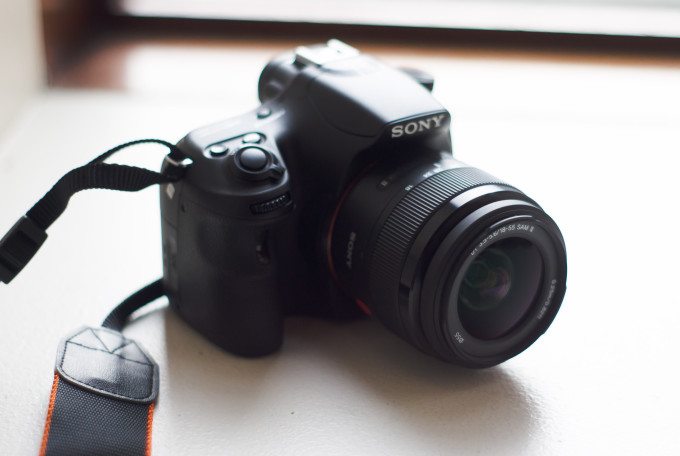
As stated previously, the a58’s SLT technology affords it the smaller form factor. With no reflecting mirror and no pentaprism to worry about, the a58 gets to be a bit smaller than its three digit OVF ancestors.
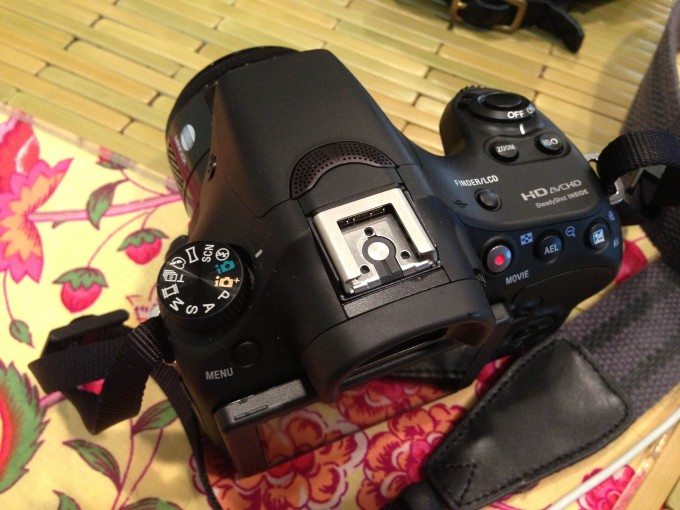
Up on top, you’ve got the mode dial with the standard P, S, A and M modes. Going clockwise from M, there’s Movie, Tele-zoom continuous priority AE, Picture Effect, Sweep Panorama, Scene, Flash off, Intelligent Auto and Superior Auto. To the right, you’ve got the on/off toggle, shutter release, ISO, Zoom, and Finder/LCD buttons.
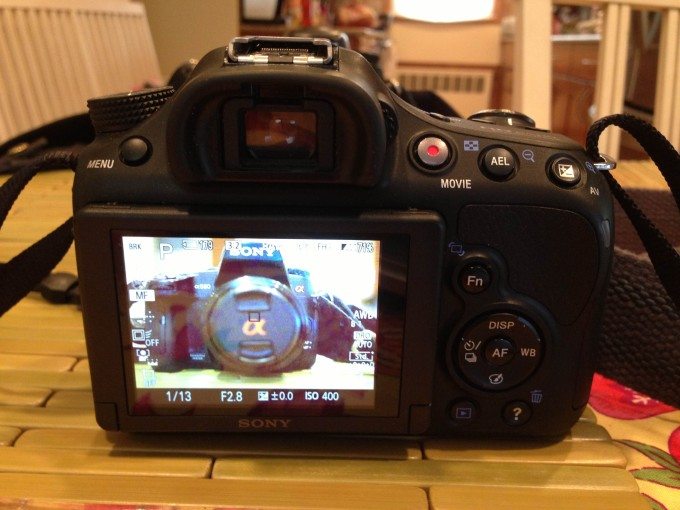
Around back, there’s the menu button to the top left. Moving along, there’s the movie, AEL, and AV buttons along the top. To the right of the LCD, there’s the Fn, AF, Playback, and ?/Trash buttons. The AF is surrounded by the Display, White Balance, Picture Effect, and Self Timer.
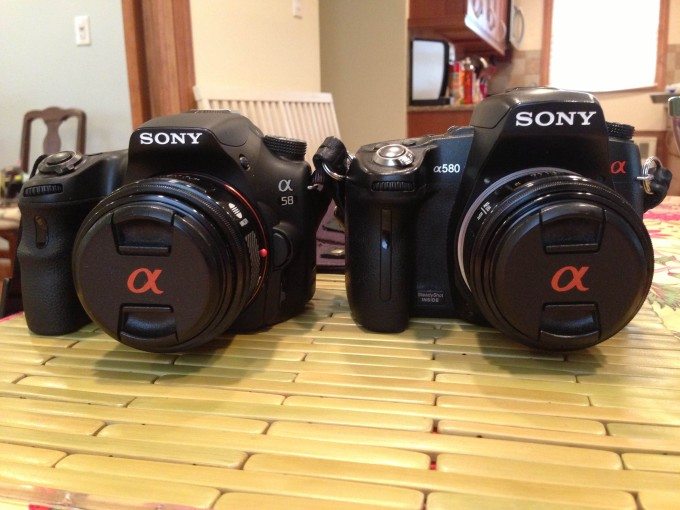
My major point of comparison is my a580 which, when held against the a58, has hard lines instead of smooth contours. The a580 looks as if it was assembled from disparate parts on an assembly line whereas the a58 looks like it was fashioned from one piece. A nice touch on the a58 is the rubber grip that has a trigger bump separating the middle finger from the ring and pinky fingers.
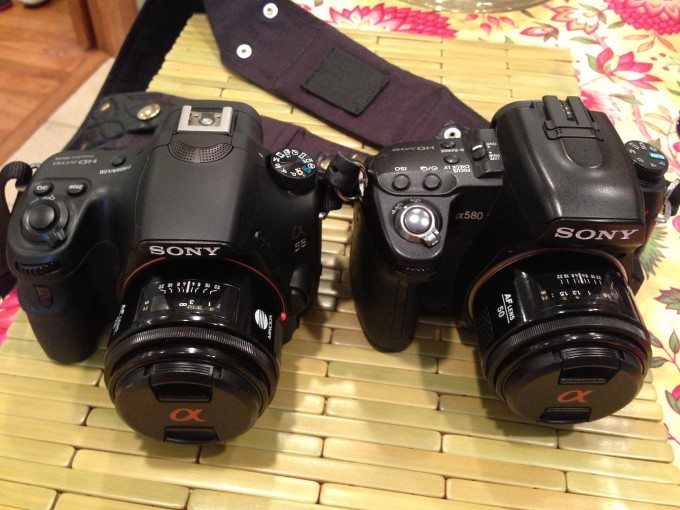
Here’s a clearer view of the a58’s smooth contours against the a580’s defined lines.
Build Quality
The a58 is built from the same hard plastic as the a580 with a texturized grip and a smaller form factor. The a58 is visually appealing, more so than the a580. Mind you, I’m not structuring this as a comparison, but more so as a study to show how Sony’s Alpha design has evolved over the years. The a58 is sturdy and tight, and it makes for a great camera on the go. A major plus is that it takes the same battery from its alpha ancestors. It would be a solid choice, both in construction and performance, for those just entering the DSLR market.
Autofocus
In the best light, the autofocus is wonderfully fast. There are three autofocus modes: Single Shot, Automatic, and Continuous. I typically had it set to Single Shot as I’m not much of a burst shooter. There are four options for AF area: Wide, Zone, Spot, and Local. I tended to do local as I like the option to select my AF point.
It lagged a bit in low light, but not so much where you’d throw up your arms in frustration.
Ease of Use
If you have experience with Sony’s Alpha line, the a58 will be a cinch. Just mind the change in location of the AEL and AV buttons. If you’re coming from an older class of alpha, you’ll find yourself pressing the AEL button more times than you’d like. If you’re new to the Alpha family, the a58 will be a great learning tool. Everything’s fairly self explanatory, easy to locate, and well spaced. The design is comfortable for most mitts, and despite its smaller size than previous models, I had no trouble getting used to it.
Metering

The camera meters perfectly according to Sunny 16 standards.
Image Quality
The Sony a58 can create some truly stunning images that work nicely in Lightroom. The colors pop, and skin tones are rendered beautifully. This is a great choice for portraitists, and I used it for a headshot session with an actor friend (one of the photos comes later on). The sensor packs a punch, and it will do wonderful things for a photographer just starting out, and given what it can produce, it will make for a great secondary camera to your main rig.
Minor tweaks were done in Lightroom 4.
RAW File Versatility
The a58 renders fairly massive RAW files, 20.1 MP a piece. Hopefully, you’ll have a fast enough card because if you try to preview them in camera immediately after shooting, you’ll be met with a red light. There’s a lot of information to work with, and you can recover a good deal in Lightroom. In the first impression, I mentioned that this camera is being marketed as “an ideal choice for consumers eager to explore the world of DSLR-style interchangeable lens technology”. This puts it as an entry level camera, and those just starting out may not have a steady grip on the power of RAW files. Should they use the a58 as learning tool, however, they’ll find that they have a lot to work with, which is definitely a boon for Sony’s efforts here.
High ISO Images
I didn’t have the a58 in very many situations where I need to crank up the ISO, but I did it it out for a spin in an abandoned anthracite factory. There was a moment where I positioned the camera in a hole in the floor to take a photo of some sodas resting at the bottom.

ISO 3200 doesn’t seem to be ideal, but it’s passable should you absolutely have to use it.
Extra Image Samples

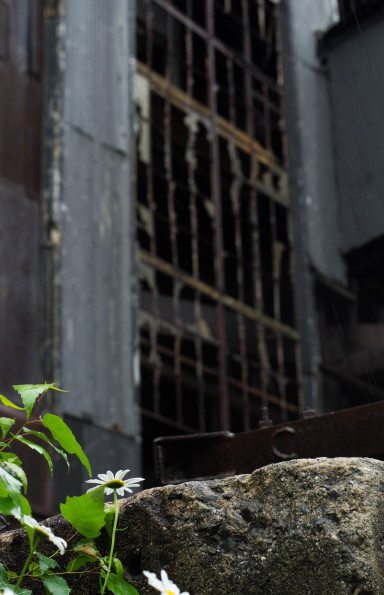

Conclusion
The a58 makes for a wonderful companion camera, or a great starting point if you’re just breaking into the DSLR realm. With an appealing design and intuitive layout (both the buttons and the menu system), it makes for a solid choice for anyone really. It should also be said that you have to be willing to break from optical viewfinders as Sony has abandoned the form in favor of EVFs and its SLT (Single Lens Translucent) technology. It can get a bit noisy in poorly lit situations, but it can do wonders in bright light. I’m a bit of a curmudgeon when it comes to viewfinders, but I found that I had warmed up to it, if ever so slightly. I still prefer my a580, the last of its kind in Sony’s alpha line, but the times have changed, and the a58 is like a slimmer, spunkier younger brother.
It’s $549 at Adorama and Amazon. That’s a great price for a great camera.
Please Support The Phoblographer
We love to bring you guys the latest and greatest news and gear related stuff. However, we can’t keep doing that unless we have your continued support. If you would like to purchase any of the items mentioned, please do so by clicking our links first and then purchasing the items as we then get a small portion of the sale to help run the website.



